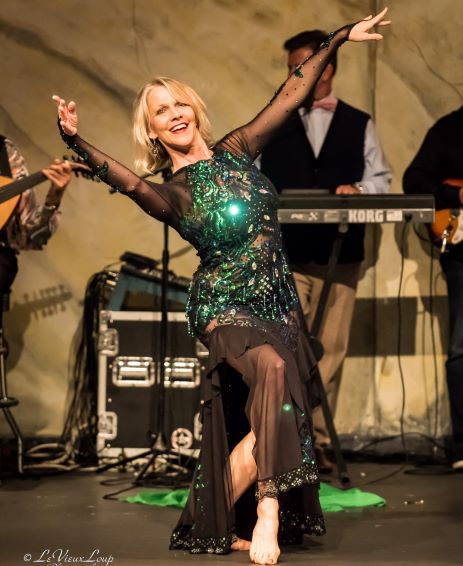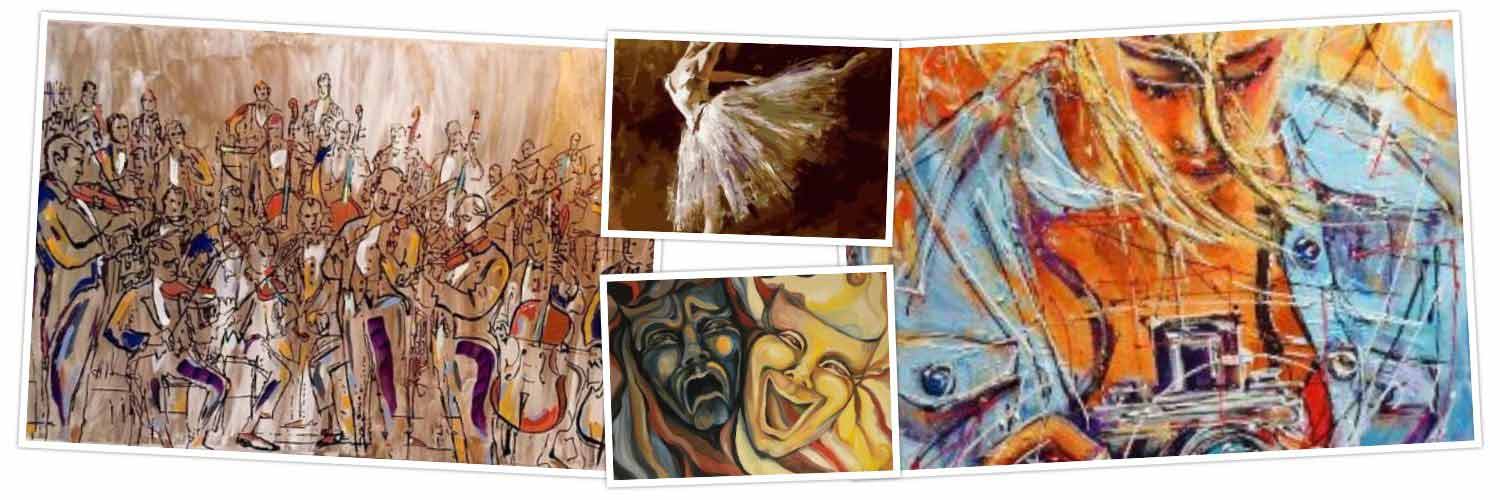Karen Barbee Adkisson, Belly Dancer, Founder/Owner of Karavan Studio
By JASMINA WELLINGHOFF, Editor
How did you discover belly dancing?
My oldest sister Barbara who lived in Hawaii for a while when our father was in the Air Force learned how to do the hula while she was there. As a child, I was taking dance classes – ballet, jazz and tap – at Dorothy Keck Dance Studio here in San Antonio, and Dorothy invited Barbara to teach hula dance at her studio. At the time – it was 1972 – I kept hearing about this belly dancing thing and asked Barbara if she knew anything about it. She didn’t but she was willing to learn. So, she started learning about it, and I just went along because she was my cool big sister. She took classes wherever she could, going to Houston and Dallas for workshops I went with her. I baby-sat her little girl while she was in the workshops but I also watched the dancing. Eventually, she started teaching belly dance at the Dorothy Keck Studio, and I added those classes to all my other dance classes.
When I was 18 Barbara had her third child, and decided to turn over some of her classes to me. And I’ve been doing it ever since.
Did it appeal to you more than the other genres?
At that time, it was just another form of movement and I liked dancing. I was not aware of the cultural background behind it. Even the music sounded odd to me but I liked the movement. I was in Catholic schools all my life, and belly dancing was a little weird, so I liked that, too (laughs). I did not get a deeper appreciation for it until I interacted with people from the Near and Middle East.

I finally took it seriously when I quit my corporate job in 1988. By that time, I was dancing in nightclubs in Houston and I learning more about belly dancing – the music, the culture, the traditions of a people. Also, I was making quite a bit of money. Then I decided to open a teaching studio in San Antonio. I had students right away. (Though she later returned to a corporate job for a while, she eventually realized that belly dancing would be her career.)
Tell us about the historical roots of belly dancing?
I have read a lot about the origins of belly dance, much of it conflicting with itself. It simply isn’t the type of information that I retain. My husband is the history buff in the family, not me.I encourage my students to check out an excellent website, shira.net, if they ask me about it. Personally, while I respect what I have learned about those who came before me, and especially those who brought the dance to the United States, I look at this dance in a “from my life forward” kind of way. As a performing artist in San Antonio, Texas, I ask, “what can I now contribute?”
How many students do you have at present?
In 2007 I had 300, but I have scaled down since. Now, I have probably between 75 and 100. It’s popular, and it’s a great form of exercise, something people turn to when they are tired of just doing sit-ups. Many say, “I am here for the exercise and will never perform,” but so many were in my show just a couple of weeks ago.
Your husband was a politician (Tommy Adkisson). Was he OK with you being a belly dancer and teacher?
He was. What we have in common is the belief that each person should find what they love to do and do it, period!
Where do you find the musicians to play for your performances?
I have to import them. When I was dancing in the clubs in Houston, I met a family of musicians, the brothers Ghafour, and I have been working with them for 30 years. Over the years, I found others from other cities, including a man who plays the Arabic flute, the nay. He’s Michael Ibrahim from Detroit, who is the founder and conductor of the National Arab Orchestra. My life changed! (laughs) (Karavan Studio recently hosted The National Arab Orchestra which performed downtown at the Buena Vista Theater.)
What are your interests aside from dance?
These days, the answer is puppies. When Tommy was running for mayor we met with a group of animal-rescue people who were very serious about their work. As a consequence, I started noticing the strays, and then, I couldn’t stop noticing them. In 2015, we adopted Riley. Then in 2016, a neighbor was looking to place two puppies because she could not keep them. I looked at them: “Oh my God they are so cute! (And she ended up adopting them, too.) Then there was this Pitbull wandering the street of my neighborhood and I was scared of that dog. But the dog endeared herself to me. Now Petunia, that’s her name, lives at our house. She is a brilliant dog. (A small brown puppy that started following her, became the fifth adoptee.) I spend time every day managing this canine society.
Who had the greatest influence on you growing up?
My dad. We did not have a close relationship but that’s probably why. I was the fourth child born after the one who had special needs. I was the child who did not want to cause any trouble but I still wanted attention. So, I was a straight A student, graduated from high school at 16, and I graduated from college at 19. But, maybe my special-needs sister was really the big influence, indirectly. My dad was always someone I looked up to. Unfortunately, he was very mad at me when I quit my job at USAA to dance.
What is your greatest regret?
(after some thinking) OK, I’ll go with three. I put people who have advanced degrees on a pedestal. So, I started a master’s degree which I never finished. Then when I started working at USAA, I thought I should get an MBA and the company was willing to pay for it. But I didn’t really want it. I was not interested. So, I dropped out. Then I got into the mentoring program at USAA, and I was going to schools and working with kids. I enjoyed that, so I decided to get a master’s in education at Trinity University. And again, I realized I did not want to pursue that course, so I quit. (The last educational path she abandoned was a study of Arabic culture at UT Austin) I think I would have finished that one had I not become so busy at the studio. If you add all the hours together, I have a master’s in business-education-Arabic-study-ish. (We both laugh)
Where do you like to shop in San Antonio?
I like Lululemon over at the Quarry. They have great workout clothes. I also like Old Navy. These days I mostly wear workout clothes.
Have you ever been in a situation where you were truly frightened?
Yes. I visited the Palestinian territories in the Near East. I was so excited. But it wasn’t what I had thought it would be. At several checkpoints soldiers had guns drawn, and tanks nearby. And they were not kidding. I just thought, ‘this is the dumbest thing I have ever done. This was in 2002 and I thought no one was going to hurt me as an American. But once there, I was petrified.
As a San Antonian, what issues do you consider important for our city?
Wow! I wish we could find a way to help older neighborhoods. When I went to the Palestinian territories on the West Bank and in Gaza, I saw refugee camps and then the big, gorgeous Israeli settlements. We have that kind of thing here. My studio is on S. Laredo on the other side of 35, and just beyond my place, it looks like a refugee camp. There are scary places. But on the other side is Southtown and it’s gorgeous. I know it’s not easy to get areas of the city more equalized. But absent any deliberate focus on that, it sure as hell isn’t going to happen. Arts organizations like mine may be a catalyst for change.
